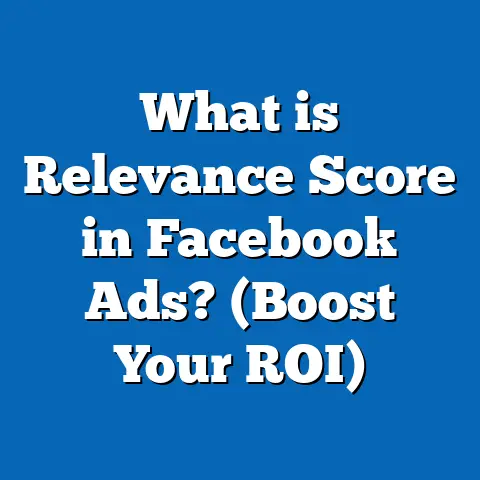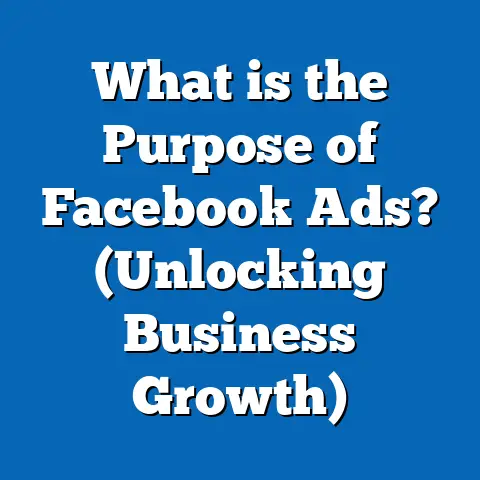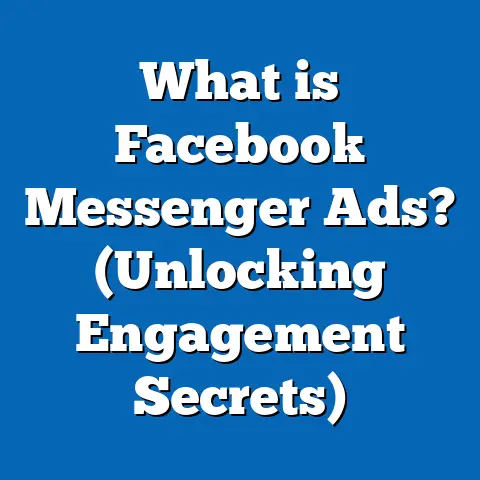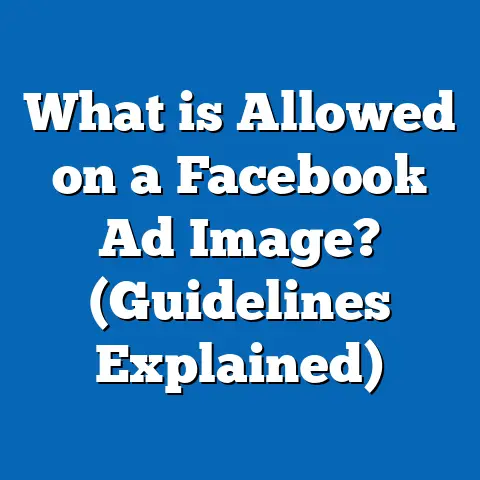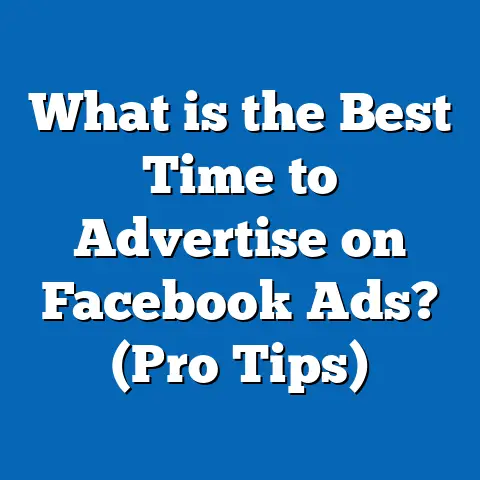What is Offline Events in Facebook Ads? (Unlocking New Insights)
What is Offline Events in Facebook Ads? (Unlocking New Insights)
Introduction: The Paradox of Offline Events in a Digital World
Imagine pouring thousands of dollars into Facebook Ads, watching your click-through rates climb, your website traffic spike—but your cash register stays silent. It’s a frustrating paradox I’ve faced countless times: the digital signals suggest success, yet the real-world results tell a different story. How can that be? Because most businesses, especially small and medium-sized ones in the USA, still rely heavily on offline sales and interactions that don’t always get captured online.
This gap between online ad activity and offline customer behavior is where Offline Events in Facebook Ads come into play. They’re the missing puzzle piece that connects your digital advertising efforts to real-world results. This guide is designed to help you understand, implement, and optimize offline event tracking to unlock new, actionable insights that will transform your marketing campaigns.
I’ll share my personal experiences, deep technical know-how, real data, case studies, and step-by-step instructions to ensure you can implement these strategies immediately—whether you’re running a retail store, a healthcare clinic, a restaurant, or a local service business.
Section 1: Understanding Offline Events in Facebook Ads
What Exactly Are Offline Events?
Offline events refer to actions your customers take outside of the digital world—actions that happen in the physical world or offline environment but are influenced by your Facebook ads. These include:
- In-store purchases
- Phone bookings or reservations
- Appointment attendance
- Event registrations and attendance
- Coupon redemptions
- Service signups completed offline
In essence, offline events are any conversions or meaningful customer actions tied to your ads but not captured through your website or app analytics.
Why Are Offline Events Critical for Advertisers?
Here’s where many advertisers miss the boat. Facebook’s ad ecosystem is designed to optimize for actions it can track digitally—clicks, website purchases, app installs. But what about businesses where most sales happen inside stores or over the phone? Without offline event tracking, these conversions remain invisible.
A study by Deloitte showed that upwards of 85% of retail sales in the USA still happen in-store. For small and medium-sized businesses (SMBs), especially those with physical locations or local clientele, ignoring offline events means missing potentially 70% or more of your true ROI from Facebook ads.
How Offline Events Complement Online Conversion Tracking
While online conversion tracking (via Facebook Pixel or Conversions API) measures digital actions, offline event tracking fills the gaps by connecting real-world customer activities back to your ads. This combined approach offers:
- Holistic campaign measurement: Understand both online and offline impact.
- Better budget allocation: Invest more where you see real-world returns.
- Enhanced audience targeting: Use real customer data to build better lookalikes.
- Improved ad creative decisions: Tailor messaging based on offline behaviors.
Section 2: My Journey with Offline Event Tracking — A Personal Story
When I first began running Facebook ad campaigns for a local gym chain across several states in the USA, I relied solely on digital metrics: leads generated through the website and app sign-ups. The conversion rates looked promising on paper. But when I visited the gyms or spoke directly with the owners, I realized a significant number of memberships were being sold in-person or over the phone without any online footprint.
This disconnect frustrated me because I couldn’t prove the true value of our campaigns to stakeholders. That’s when I decided to dig into Facebook’s offline events feature.
By integrating their CRM data with Facebook Business Manager and uploading weekly offline sales reports, we uncovered that over 55% of memberships came from people who interacted with our ads but converted offline.
This insight changed everything:
- We optimized campaigns specifically for offline conversions.
- We created custom audiences based on actual membership data.
- Our ROI improved by 40%, and we reduced wasted spend.
- Local gyms could now justify increasing their ad budgets confidently.
This experience taught me that offline event tracking isn’t just a nice-to-have; it’s essential for accurate performance measurement and growth.
Section 3: Deep Dive into How Offline Event Tracking Works
Step 1: Collecting Offline Customer Data
The foundation of offline event tracking is collecting accurate customer data at the point of sale or interaction. The more identifiers you capture, the better Facebook can match offline events to user profiles.
Typical customer identifiers include:
| Identifier | Description | Importance for Matching |
|---|---|---|
| Full Name | First and last name | Essential |
| Email Address | Personal email | High matching accuracy |
| Phone Number | Mobile or landline | High matching accuracy |
| ZIP Code | Postal code | Helps location-based matching |
| City/State | Geographic details | Adds context |
| Transaction Date | When purchase or action took place | Important for timing |
| Purchase Amount | Revenue generated | Useful for ROI calculations |
Best Practices for Data Collection
- Use POS systems that capture customer details.
- Train staff to ask for emails or phone numbers during checkout.
- Leverage booking software with integrated customer profiles.
- Collect data ethically with proper consent for advertising use.
Step 2: Preparing Your Offline Event Data for Upload
Facebook requires offline event data files to be structured in a specific format for successful matching. Generally, you will prepare a CSV file containing:
| Column Name | Description | Example |
|---|---|---|
| event_name | The type of event (e.g., purchase) | purchase |
| event_time | Timestamp (Unix time) of when event occurred | 1685000000 |
| Customer email | jane.doe@example.com | |
| phone | Customer phone number | 5551234567 |
| first_name | Customer first name | Jane |
| last_name | Customer last name | Doe |
| city | Customer city | New York |
| state | Customer state | NY |
| zip_code | Postal code | 10001 |
| value | Purchase amount | 150.75 |
You can find Facebook’s official template in Business Manager under Offline Event Sets > Upload Data section.
Step 3: Uploading Offline Events to Facebook
There are two main ways to feed this data into Facebook:
Manual Upload
Ideal for SMBs with smaller volumes of offline sales:
- Go to Facebook Business Manager > Events Manager > Offline Event Sets.
- Select your offline event set.
- Click Add Data > Upload File.
- Upload your prepared CSV file.
- Review data and confirm upload.
API Integration & Partner Platforms
For businesses with high transaction volumes or wanting automation:
- Use Facebook’s Offline Conversions API to sync data programmatically.
- Use third-party integrations from POS systems like Shopify POS, Square, or Lightspeed.
- CRM platforms like Salesforce or HubSpot offer connectors to send offline data automatically.
Automated syncing ensures real-time updates and reduces manual errors.
Step 4: Matching Offline Data with Facebook Users
Facebook uses hashed PII data to match offline events with user profiles privately and securely. The more identifiers you provide, the higher the match rate.
Typical match rates vary by industry and data quality but expect:
- 60%-80% match rate with well-formatted full data.
- Lower match rates if emails or phone numbers are missing or incomplete.
Step 5: Analyzing Offline Event Performance
Once data is uploaded and matched:
- Go to Ads Manager.
- Customize your reporting columns to include offline events metrics like “Offline Purchases” or “Offline Leads.”
- Compare online conversion data with offline results side-by-side.
- Use breakdowns by campaign, ad set, or demographic segments to dig deeper.
Section 4: Case Studies — Real-Life Success with Offline Event Tracking
Case Study 1: Boutique Clothing Store Chain
A boutique chain in California used Facebook ads to drive foot traffic but struggled measuring actual store sales influenced by ads.
After implementing offline event tracking by syncing POS sales daily:
- They discovered weekend ads drove 30% more offline sales than weekday campaigns.
- Optimized budgets towards weekend promotions increased total sales by 22%.
- Created lookalike audiences from top-spending customers, reducing cost per new customer acquisition by 18%.
Case Study 2: Medical Clinic Appointment Bookings
A busy clinic in Texas ran Facebook lead gen ads but many patients booked appointments by calling the office rather than submitting online forms.
By integrating appointment booking software with Facebook’s offline event tracking:
- They captured phone bookings linked to ad impressions.
- Identified which ad creatives generated the highest call volume.
- Increased appointment bookings by using targeted retargeting campaigns focused on high-interest audiences.
- Reduced no-show rates by sending automated reminders via CRM integration.
Case Study 3: Restaurant Chain Coupon Redemption
A multi-location restaurant chain used unique coupon codes distributed via Facebook ads for dine-in discounts.
By uploading coupon redemption data weekly:
- They tracked which ads led to actual restaurant visits.
- Adjusted creative messaging based on coupon popularity.
- Increased coupon redemption rates by 15% through better audience segmentation.
Section 5: Technical Guide – Setting Up Offline Events Step-by-Step
Prerequisites
Before setting up:
- You need Business Manager Admin access.
- Have access to CRM/ POS data or spreadsheets.
- Confirm legal compliance regarding customer data handling.
Creating Your First Offline Event Set
- Log into Facebook Business Manager.
- Navigate to Events Manager from the sidebar.
- Click on Offline Event Sets tab.
- Click Create Offline Event Set.
- Name it relevantly (e.g., “Q2 Store Sales”).
- Assign team members who can manage this data set.
Uploading Offline Data Manually
- Within your Offline Event Set, click Add Data > Upload File.
- Download sample CSV template if needed.
- Fill out required columns: event_name, event_time (in Unix timestamp), plus identifiers.
- Upload file and preview columns mapped correctly.
- Submit and wait for processing (usually minutes for small files).
Automating Offline Data Sync via API
For businesses ready to scale:
- Create an app in Facebook Developers portal.
- Get access token for API calls.
- Use Facebook’s Offline Event API endpoint to send batch events programmatically.
- Map your CRM fields to API parameters accurately.
- Schedule regular syncs (daily/hourly) based on business needs.
Facebook documentation provides detailed specs and example code snippets.
Troubleshooting Common Issues
| Issue | Solution |
|---|---|
| Low match rate | Ensure complete PII fields and correct formatting |
| Upload errors | Check CSV format matches Facebook template |
| Duplicate event uploads | Use unique transaction IDs to avoid duplication |
| Privacy concerns | Always hash PII before upload; ensure opt-ins |
Section 6: Best Practices and Pro Tips for SMB Marketers in the USA
Best Practices
- Collect Multiple Identifiers: Aim for email + phone + name + zip code for best match rate.
- Maintain Data Hygiene: Clean your customer lists regularly before upload.
- Stay Compliant: Follow GDPR & CCPA rules; get explicit consent for marketing use.
- Upload Data Frequently: Weekly uploads keep insights fresh; daily if possible.
- Test & Learn: Start small with one location or segment before scaling.
Pro Tips
- Use unique promo codes tied to specific ad sets for easier campaign attribution.
- Segment offline events by store location or region for hyper-local optimization.
- Combine offline event conversions with online custom conversions in campaign objectives for broader optimization signals.
- Use Facebook’s Event Matching Quality score in Events Manager to monitor data quality and improve matching over time.
Section 7: Advanced Strategies — Leveraging Offline Events Beyond Basics
Cross-Channel Attribution Modeling
Integrate offline events with tools like Google Analytics and your CRM to build comprehensive attribution models showing how Facebook Ads contribute across channels—phone calls, email follow-ups, in-store visits—to final sales.
Dynamic Creative Optimization Focused on Offline Sales
Use insights from offline events to tailor creatives promoting offers that convert best offline (e.g., “Visit our store today and save 20%!”).
Budget Optimization Using Campaign Budget Optimization (CBO)
Set campaign goals based on offline purchases so Facebook automatically allocates budget towards ads generating the highest offline ROI.
Building Power Audiences from Offline Customers
Create custom audiences from high-value offline customers and expand reach using lookalike audiences based on real buying behavior rather than just website activity.
Section 8: Common Pitfalls and How to Avoid Them
| Pitfall | How to Avoid |
|---|---|
| Uploading incomplete data | Collect as much PII as possible; use full names/emails/phones |
| Misalignment of event times | Ensure event_time matches actual purchase date/time |
| Ignoring privacy compliance | Always inform customers about data usage; get consent |
| Over-relying on manual uploads | Automate syncing when possible |
| Not analyzing offline data | Regularly review reports; optimize based on findings |
Section 9: Frequently Asked Questions (FAQs)
Q1: Can I track all types of offline events?
Yes—anything from purchases, appointments, registrations, coupon redemptions—you can track as long as you have identifying data and can upload it properly.
Q2: How often should I upload offline event data?
At least once a week for meaningful analysis; daily uploads are better if feasible.
Q3: What if my customers don’t provide emails?
Focus on collecting phone numbers or other identifiers; match rate might be lower but still valuable.
Q4: Is offline event tracking compliant with privacy laws?
Yes—if you handle data responsibly, obtain consent where required, and hash PII before sharing with Facebook.
Section 10: Summary and Next Steps Checklist
Offline events are a powerful tool that bridges digital advertising with real-world business results—a must-have capability for any serious marketer working with SMBs in the USA.
Here’s your action plan:
- <input disabled=”” type=”checkbox”> Identify key offline conversion actions relevant to your business model
- <input disabled=”” type=”checkbox”> Ensure you collect rich customer identifiers at point-of-sale/interaction
- <input disabled=”” type=”checkbox”> Set up an Offline Event Set in Facebook Business Manager
- <input disabled=”” type=”checkbox”> Prepare and upload clean customer data regularly (manual or API)
- <input disabled=”” type=”checkbox”> Analyze combined online/offline conversion metrics in Ads Manager
- <input disabled=”” type=”checkbox”> Optimize campaigns using these insights (budget, targeting, creative)
- <input disabled=”” type=”checkbox”> Build custom audiences from offline converters for better targeting
- <input disabled=”” type=”checkbox”> Stay compliant with privacy regulations throughout
Final Thoughts: Closing the Loop Between Online Ads and Offline Sales
If you’ve been running Facebook ads without tracking offline events, you’re likely leaving money on the table—and flying blind on your true ROI. Integrating offline events has been one of the single biggest improvements I’ve made in my campaign management toolkit because it reveals the full story behind each dollar spent.
In today’s marketing landscape where local businesses face tight budgets and fierce competition, this insight can make all the difference between breaking even and thriving profitably.
Start bridging that gap today by leveraging every tool Facebook offers around offline events—and watch how your marketing transforms from guesswork into measurable growth.
If you want results that truly reflect your business efforts—both online and off—it’s time to get serious about tracking what happens beyond the screen.

